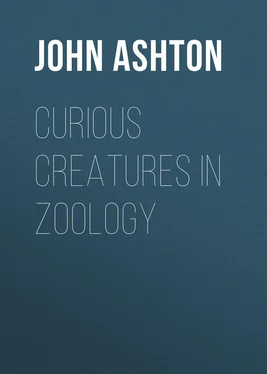John Ashton - Curious Creatures in Zoology
Здесь есть возможность читать онлайн «John Ashton - Curious Creatures in Zoology» — ознакомительный отрывок электронной книги совершенно бесплатно, а после прочтения отрывка купить полную версию. В некоторых случаях можно слушать аудио, скачать через торрент в формате fb2 и присутствует краткое содержание. Жанр: Природа и животные, foreign_antique, foreign_prose, на английском языке. Описание произведения, (предисловие) а так же отзывы посетителей доступны на портале библиотеки ЛибКат.
- Название:Curious Creatures in Zoology
- Автор:
- Жанр:
- Год:неизвестен
- ISBN:нет данных
- Рейтинг книги:4 / 5. Голосов: 1
-
Избранное:Добавить в избранное
- Отзывы:
-
Ваша оценка:
- 80
- 1
- 2
- 3
- 4
- 5
Curious Creatures in Zoology: краткое содержание, описание и аннотация
Предлагаем к чтению аннотацию, описание, краткое содержание или предисловие (зависит от того, что написал сам автор книги «Curious Creatures in Zoology»). Если вы не нашли необходимую информацию о книге — напишите в комментариях, мы постараемся отыскать её.
Curious Creatures in Zoology — читать онлайн ознакомительный отрывок
Ниже представлен текст книги, разбитый по страницам. Система сохранения места последней прочитанной страницы, позволяет с удобством читать онлайн бесплатно книгу «Curious Creatures in Zoology», без необходимости каждый раз заново искать на чём Вы остановились. Поставьте закладку, и сможете в любой момент перейти на страницу, на которой закончили чтение.
Интервал:
Закладка:
“But the true morall of this poetical fiction is by that learned Alciatus , in one of his emblems, deciphered; that her monstrous treble formed shape signified her lustfull pleasure under a Virgin’s face, her cruell pride, under the Lyon’s clawes, her winde-driven leuitye, under the Eagles, or birdes feathers, and I will conclude with the wordes of Suidas concerning such monsters, that the Tritons , Sphinges , and Centaures , are the images of those things, which are not to be founde within the compasse of the whole world.”
Apes
Sluper, who could soar to the height of delineating a Cyclops, is equal to the occasion when he has to deal with Apes, and here he gives us an Ape which, unfortunately, does not seem to have survived to modern times – namely, one which wove for itself coarse cloth, probably of rushes; had a cloak of skin, and walked upright, with the aid of a walking-stick, and was so genteel, that, having no boots, he seems to have blacked his feet. And thus he sings of it:
“Pres le Peru par effect le voit on,
Dieu a donné au Singe telle forme.
Vestu dejonc, s’appuyant d’un baston,
Estãt debout, chose aux hõmes cõforme.”
Before quitting the subject of Apes, I cannot refrain from noticing another of this genus mentioned by Topsell, and that is the Arctopithecus or Bear Ape: – “There is in America a very deformed beast, which the inhabitants call Haut or Hauti , and the Frenchmen Guenon , as big as a great Affrican Monkey. His belly hangeth very low, his head and face like unto a childes, and being taken, it will sigh like a young childe. His skin is of an ashe-colour, and hairie like a Beare: he hath but three clawes on a foote, as longe as foure fingers, and like the thornes of Privet, whereby he climbeth up into the highest trees, and for the most part liveth of the leaves of a certain tree, beeing of an exceeding heighth, which the Americans call Amahut , and thereof this beast is called Haut . Their tayle is about three fingers long, having very little haire thereon; it hath beene often tried, that though it suffer any famine, it will not eate the fleshe of a living man, and one of them was given me by a French-man, which I kept alive sixe and twenty daies, and at the last it was killed by Dogges, and in that time when I had set it abroad in the open ayre, I observed that, although it often rained, yet was that beast never wet . 27 27 The italics are mine. – J. A.
When it is tame, it is very loving to a man, and desirous to climbe uppe to his shoulders, which those naked Amerycans cannot endure, by reason of the sharpnesse of his Clawes.”
Animal Lore
We are indebted to Pliny for much strange animal lore – which, however, will scarcely bear the fierce light of modern investigation. Thus, he tells us of places in which certain animals are not to be found, and narrates some very curious zoological anecdotes thereon. “It is a remarkable fact, that nature has not only assigned different countries to different animals, but that even in the same country it has denied certain species to certain localities. In Italy, the dormouse is found in one part only, the Messian forest. In Lycia, the gazelle never passes beyond the mountains which border upon Syria; nor does the wild ass in that vicinity pass over those which divide Cappadocia from Cilicia. On the banks of the Hellespont, the stags never pass into a strange territory, and, about Arginussa, they never go beyond Mount Elaphus; those upon the mountains, too, have cloven ears. In the island of Poroselene, the weasels will not so much as cross a certain road. In Bœotia, the moles, which were introduced at Lebadea, fly from the very soil of that country, while in the neighbourhood, at Orchomenus, the very same animals tear up all the fields. We have seen coverlets for beds made of the skin of these creatures, so that our sense of religion does not prevent us from employing these ominous animals for the purposes of luxury.
“When hares have been brought to Ithaca, they die as soon as ever they touch the shore, and the same is the case with rabbits, on the shores of the island of Ebusus; while they abound in the vicinity, Spain namely, and the Balearic isles. In Cyrene, the frogs were formerly dumb, and this species still exists, although croaking ones were carried over there from the Continent. At the present day, even, the frogs of the island of Seriphos are dumb; but when they are carried to other places, they croak; the same thing is also said to have taken place at Sicandrus, a lake of Thessaly. In Italy, the bite of a shrew-mouse is venomous; an animal which is not to be found in any region beyond the Apennines. In whatever country it exists, it always dies immediately if it goes across the rut made by a wheel. Upon Olympus, a mountain of Macedonia, there are no wolves, nor yet in the isle of Crete. In this island there are neither foxes nor bears, nor, indeed, any kind of baneful animal, with the exception of the phalangium, a species of spider. It is a thing still more remarkable, that in this island there are no stags, except in the district of Cydon; the same is the case with the wild boar, the woodcock, and the hedgehog.”
He further tells us of animals which will injure strangers only, as also animals which injure the natives only.
“There are certain animals which are harmless to the natives of the country, but destroy strangers; such as the little serpents at Tirynthus, which are said to spring out of the earth. In Syria, also, and especially on the banks of the Euphrates, the serpents never attack the Syrians when they are asleep, and even if they happen to bite a native who treads upon them, their venom is not felt; but to persons of any other country they are extremely hostile, and fiercely attack them, causing a death attended with great torture. On this account the Syrians never kill them. On the contrary, on Latmos, a mountain of Caria, as Aristotle tells us, strangers are not injured by the scorpions, while the natives are killed by them.”
He also throws some curious light, unknown to modern zoologists, on the antipathies of animals one to another. He says: – “There will be no difficulty in perceiving that animals are possessed of other instincts besides those previously mentioned. In fact, there are certain antipathies, and sympathies among them, which give rise to various affections, besides those which we have mentioned in relation to each species, in its appropriate place. The Swan and the Eagle are always at variance, and the Raven and the Chloreus seek each other’s eggs by night. In a similar manner, also, the Raven and the Kite are perpetually at war with one another, the one carrying off the other’s food. So, too, there are antipathies between the Crow and the Owl, the Eagle and the Trochilus; between the last two, if we are to believe the story, because the latter has received the title of ‘the king of birds;’ the same, again, with the Owlet and all the smaller birds.
“Again, in relation to the terrestrial animals, the Weasel is at enmity with the Crow, the Turtle-dove with the Pyrallis, the Ichneumon with the Wasp, and the Phalangium with other Spiders. Among aquatic animals, there is enmity between the Duck and the Seamew, the Falcon known as the ‘Harpe,’ and the Hawk called the ‘Triorchis.’ In a similar manner, too, the Shrew-mouse and the Heron are ever on the watch for each other’s young; and the Ægithus, so small a bird as it is, has an antipathy for the Ass; for the latter, when scratching itself, rubs its body against the brambles, and so crushes the bird’s nest; a thing of which it stands in such dread, that, if it only hears the voice of the Ass when it brays, it will throw its eggs out of the nest, and the young ones, themselves, will, sometimes, fall to the ground in their fright; hence it is that it will fly at the Ass, and peck at its sores with its beak.
Читать дальшеИнтервал:
Закладка:
Похожие книги на «Curious Creatures in Zoology»
Представляем Вашему вниманию похожие книги на «Curious Creatures in Zoology» списком для выбора. Мы отобрали схожую по названию и смыслу литературу в надежде предоставить читателям больше вариантов отыскать новые, интересные, ещё непрочитанные произведения.
Обсуждение, отзывы о книге «Curious Creatures in Zoology» и просто собственные мнения читателей. Оставьте ваши комментарии, напишите, что Вы думаете о произведении, его смысле или главных героях. Укажите что конкретно понравилось, а что нет, и почему Вы так считаете.












